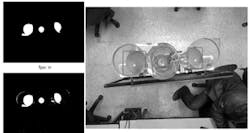Kinect system senses depth in tanks
Researchers from the Universidad Militar Neueva Granada (Bogota, Colombia) have developed a system that uses a Microsoft Kinect sensor coupled with proportional fuzzy logic controllers to detect and control the levels of liquids in tanks.
By applying image processing techniques on the RGB image data that was collected from the Kinect sensor, the researchers demonstrated that their system could be used to segment three individual tanks from a single image.
To measure the depth of the liquid in each of the tanks, the researchers dropped a float into each of the three tanks whose height was then determined by an analysis of the infra-red data captured by the Kinect. The data was then used to control the filling level for each tank using a proportional fuzzy controller and a proportional-derivative fuzzy controller.
The levels that were measured by the Kinect controller were compared with those obtained by an industrial ultrasonic sensor. Having done so, the researchers concluded that the Kinect not only offered good precision but also had some inherent advantages over conventional sensors such as price.
Details of the system were presented in a technical paper that was published in the Asian Transactions on Engineering this month. Entitled "Level measurement comparison between 3D vision system based on Kinect and ultrasonic industrial sensor," it can be found here.
Editor's note: Readers interested in the Microsoft Kinect sensor might also like to read an in-depth 35-page report entitled "Kinect Depth Sensor Evaluation for Computer Vision Applications" which was recently published by researchers at the electrical and computer engineering department at Aarhus University. That report can be found here.
Recent items on the Kinect from Vision Systems Design that you might also find of interest.
1. Kinect API makes low-cost 3-D imaging systems attainable
Microsoft's Kinect is stirring up new interest in 3-D imaging due to its low cost and 'hack-ability' by novices and experts alike
2. How accurate is the Kinect?
An assistant professor at the Faculty of Geo-Information Science and Earth Observation of the University of Twente (Enschede, The Netherlands) has written a technical paper that analyses the accuracy and resolution of the depth data from the Microsoft Kinect sensor.
3. Free toolkit helps Labview developers interface to the Kinect
Researchers from the school of mechanical engineering at Leeds University (Leeds, UK) have been crowned winners of the Student Design Competition at National Instruments NI Week in Austin, Texas for creating a LabVIEW application programming interface (API) for Microsoft's Kinect software development toolkit (SDK).
Vision Systems Design magazine and e-newsletter subscriptions are free to qualified professionals. To subscribe, please complete the form here.
-- Dave Wilson, Senior Editor, Vision Systems Design
